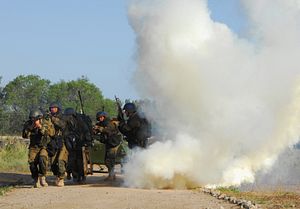Buried in remarks prepared for two Congressional committees on overall force posture, General Lloyd Austin, Commander of U.S. CENTCOM, did manage to comment on the status of relations between the U.S. military and Central Asian partners. Though considerably overshadowed by ISIS at the moment, and perpetually linked directly to Afghanistan, the U.S. military continues to maintain and build ties with Central Asia.
The first hearing, on March 3 with the House Armed Services Committee, was ostensibly geared toward receiving testimony on President Obama’s proposed authorization for the use of military force against ISIS and U.S. policy, strategy, and posture in the Greater Middle East (CENTOM’s area of operations spans from Egypt to Pakistan, Yemen to Kazakhstan, covering 27 countries). The commander’s comments on Central Asia managed to shine a dim light on U.S. military engagement with one of the least democratic regions in the world.
Austin noted that with the downsizing of U.S. and international military forces in neighboring Afghanistan, Central Asian states are looking to hedge on security issues in order “to position themselves to protect their own interests in the event that the Afghan government cannot maintain internal stability.” He categorized Russian influence on the region, through various “economic, military, and informational means,” as undermining the sovereignty of the region’s states and drew a brief parallel to Ukraine, saying Russian actions there had put pressure on Central Asia’s former Soviet republics.
Each of the five Central Asian states earned a paragraph in Austin’s remarks, demonstrating appropriately the level of interaction. Austin outlined the extent of military cooperation between the U.S. and each country, leading with Uzbekistan. Unsurprisingly, counterterrorism and counternarcotics make an appearance in reference to each state except Turkmenistan, which maintains a neutrality policy, and Kazakhstan, which garnered the accolade of being one of the “most well developed” relationships in the region.
Kazakhstan, which boasts the region’s largest economy and is a founding member of the Eurasian Economic Union (EEU), is also host to Steppe Eagle, an annual multinational peacekeeping exercise co-sponsored by the U.S. The 2015 iteration is to be held in April and June in Kazakhstan. Steppe Eagle is small, as military exercises go, in 2014 involving under 200 Kazakh troops from a dedicated peacekeeping battalion known as Kazbat as well as troops from Tajikistan, Kyrgyzstan, the U.S., the U.K., and Germany.
Uzbekistan, the recent recipient of more than 300 Mine-Resistant Ambush Protected (MRAP) vehicles, provided through the Excess Defense Articles program, is specifically highlighted in relation to the Northern Distribution Network (NDN). Austin comments that by allowing the U.S. access to the NDN, Uzbekistan is demonstrating commitment to regional stability. Uzbekistan’s neighbors may have room to contest this claim. For example, after eight months of stoppage Uzbekistan finally allowed gas to flow into southern Kyrgyzstan in December. The two states have long bickered over their ill-defined border in the Fergana Valley and Kyrgyzstan, since the revolution sparking a change of government in 2010, has haphazardly dealt with tensions between ethnic Uzbeks and Kyrgyz in the south.
Indeed, although Austin mentioned regional security, stability, and integration throughout his remarks regarding Central Asia, he also noted that all five of the region’s states prefer bilateral to multilateral military relationships.
Austin’s March 26 testimony for the Senate Armed Services Committee differed little from his earlier remarks except in reference to Turkmenistan. The country, neutral since its independence from the Soviet Union in 1991, has “recently expressed a desire to acquire U.S. military equipment and technology to address threats to their security along their southern border with Afghanistan,” according to Austin.
Turkmenistan’s peculiar border with Afghanistan has been the subject of several incidents. Lately, there have also been rumors of Uzbek and Russian troop movements. Although the rumors remain unconfirmed, Turkmenistan has taken increased steps to counter threats from the Taliban, just across the Amu Darya river. The threat of ISIS, though it may be overhyped by the region’s authoritarian leaders, also contributes to this shift in attitude with reference to a military relationship with the U.S.
Central Asia holds a significant corner in CENTCOM’s area of responsibility, though it occupies a much smaller space in the political sphere driving the command’s posture and mission. U.S.-Central Asian relations have always been marked by hedging on all sides and continue to exist as a balancing act between various imperatives, with the security piece often the simplest and largely removed from messier political concerns.

































